Emerin deficiency drives MCF7 cells to an invasive phenotype
- PMID: 39198511
- PMCID: PMC11358522
- DOI: 10.1038/s41598-024-70752-5
Emerin deficiency drives MCF7 cells to an invasive phenotype
Erratum in
-
Correction: Emerin deficiency drives MCF7 cells to an invasive phenotype.Sci Rep. 2025 Jul 29;15(1):27632. doi: 10.1038/s41598-025-13048-6. Sci Rep. 2025. PMID: 40730619 Free PMC article. No abstract available.
Abstract
During metastasis, cancer cells traverse the vasculature by squeezing through very small gaps in the endothelium. Thus, nuclei in metastatic cancer cells must become more malleable to move through these gaps. Our lab showed invasive breast cancer cells have 50% less emerin protein resulting in smaller, misshapen nuclei, and higher metastasis rates than non-cancerous controls. Thus, emerin deficiency was predicted to cause increased nuclear compliance, cell migration, and metastasis. We tested this hypothesis by downregulating emerin in noninvasive MCF7 cells and found emerin knockdown causes smaller, dysmorphic nuclei, resulting in increased impeded cell migration. Emerin reduction in invasive breast cancer cells showed similar results. Supporting the clinical relevance of emerin reduction in cancer progression, our analysis of 192 breast cancer patient samples showed emerin expression inversely correlates with cancer invasiveness. We conclude emerin loss is an important driver of invasive transformation and has utility as a biomarker for tumor progression.
Keywords: Breast cancer; Emerin; Metastasis; Nucleoskeleton.
© 2024. The Author(s).
Conflict of interest statement
The authors declare no competing interests.
Figures


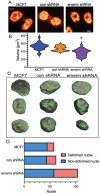
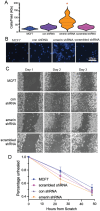
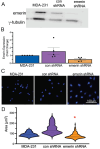
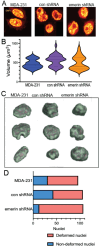
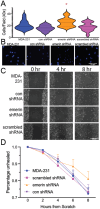
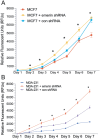


Update of
-
Emerin deficiency drives MCF7 cells to an invasive phenotype.bioRxiv [Preprint]. 2024 Aug 7:2024.02.21.581379. doi: 10.1101/2024.02.21.581379. bioRxiv. 2024. Update in: Sci Rep. 2024 Aug 28;14(1):19998. doi: 10.1038/s41598-024-70752-5. PMID: 38712242 Free PMC article. Updated. Preprint.
Similar articles
-
Emerin deficiency drives MCF7 cells to an invasive phenotype.bioRxiv [Preprint]. 2024 Aug 7:2024.02.21.581379. doi: 10.1101/2024.02.21.581379. bioRxiv. 2024. Update in: Sci Rep. 2024 Aug 28;14(1):19998. doi: 10.1038/s41598-024-70752-5. PMID: 38712242 Free PMC article. Updated. Preprint.
-
Emerin Dysregulation Drives the Very-Small-Nuclear Phenotype and Lineage Plasticity That Associate with a Clinically Aggressive Subtype of Prostate Cancer.Clin Cancer Res. 2025 May 15;31(10):2034-2045. doi: 10.1158/1078-0432.CCR-24-3660. Clin Cancer Res. 2025. PMID: 40063516 Free PMC article.
-
Prognostic impact of transcription factor Fra-1 in ER-positive breast cancer: contribution to a metastatic phenotype through modulation of tumor cell adhesive properties.J Cancer Res Clin Oncol. 2015 Oct;141(10):1715-26. doi: 10.1007/s00432-015-1925-2. Epub 2015 Feb 10. J Cancer Res Clin Oncol. 2015. PMID: 25666264 Free PMC article.
-
Cost-effectiveness of using prognostic information to select women with breast cancer for adjuvant systemic therapy.Health Technol Assess. 2006 Sep;10(34):iii-iv, ix-xi, 1-204. doi: 10.3310/hta10340. Health Technol Assess. 2006. PMID: 16959170
-
Systemic pharmacological treatments for chronic plaque psoriasis: a network meta-analysis.Cochrane Database Syst Rev. 2017 Dec 22;12(12):CD011535. doi: 10.1002/14651858.CD011535.pub2. Cochrane Database Syst Rev. 2017. Update in: Cochrane Database Syst Rev. 2020 Jan 9;1:CD011535. doi: 10.1002/14651858.CD011535.pub3. PMID: 29271481 Free PMC article. Updated.
Cited by
-
Lamin B loss in nuclear blebs is rupture dependent while increased DNA damage is rupture independent.bioRxiv [Preprint]. 2025 Feb 25:2025.02.24.639904. doi: 10.1101/2025.02.24.639904. bioRxiv. 2025. PMID: 40060436 Free PMC article. Preprint.
-
Nuclear envelope proteins, mechanotransduction, and their contribution to breast cancer progression.NPJ Biol Phys Mech. 2025;2(1):14. doi: 10.1038/s44341-025-00018-2. Epub 2025 May 5. NPJ Biol Phys Mech. 2025. PMID: 40337116 Free PMC article. Review.
-
The role of inner nuclear membrane protein emerin in myogenesis.FASEB J. 2025 Apr 15;39(7):e70514. doi: 10.1096/fj.202500323. FASEB J. 2025. PMID: 40178931 Free PMC article. Review.
-
Emerin expression stratification across breast cancer subtypes.bioRxiv [Preprint]. 2025 Jul 7:2025.07.03.663032. doi: 10.1101/2025.07.03.663032. bioRxiv. 2025. PMID: 40672349 Free PMC article. Preprint.
References
-
- Hanahan, D. Hallmarks of cancer: New dimensions. Cancer Discov.12(1), 31–46. 10.1158/2159-8290.CD-21-1059 (2022). - PubMed
-
- Chaffer, C. L. & Weinberg, R. A. A perspective on cancer cell metastasis. Science331(6024), 1559–1564. 10.1126/science.1203543 (2011). - PubMed
MeSH terms
Substances
Grants and funding
LinkOut - more resources
Full Text Sources
Medical
Miscellaneous

